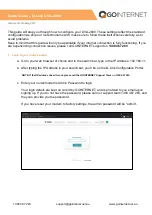
XStream
‐
PKG
‐
T™
Telephone
RF
Modem
–
Product
Manual
v5.x00
[2006.02.24]
1.5.
Pin Signals
1.5.1.
RJ-11 Connector Pin Signals
Figure
1
‐
05.
Tip
and
Ring
Pins
of
the
RJ
‐
11
Connector
Table
1
‐
04.
RJ
‐
11
Signals
and
their
implementations
on
the
XStream
‐
PKG
‐
T
RF
Modem
Pin
Pin Name
Description
Implementation
3
T1
Tip
Dial-tone and talk circuit
4
R1
Ring
Dial-tone and talk circuit
2, 5
not used
1, 6
not connected
1.5.2.
DB-9 Connector Pin Signals
Figure
1
‐
06.
Pins
of
the
Female
DB
‐
9
(RS
‐
232)
Connector
Table
1
‐
05.
DB
‐
9
(RS
‐
232)
Signals
and
their
implementations
on
the
XStream
‐
PKG
‐
T
RF
Modem
(Low
‐
asserted
signals
are
distinguished
by
horizontal
line
over
pin
name.)
Pin
Pin Name
Description
Implementation
1
Data-Carrier-Detect
Set to +5V
2
RXD
Received Data
Serial Data OUT of the RF Modem
(to host, from over-the-air))
3
TXD
Transmitted Data
Serial Data IN to the RF Modem
(from host, to be transmitted over-the-air)
4
Data-Terminal-Ready
Enables configuration (Serial Port Method) of XStream
OEM RF Module or Telephone Module
5
GND
Ground Ground
6
Data-Set-Ready
Set to +5V
7
Request-to-Send
Connects DB-9 data lines to XStream RF Module
or Telephone Module when
asserted (+10V)
8
Clear-to-Send
Set to +5V
9
RI
Ring Indicator
not used
Jumpers
Table
1
‐
06.
Jumpers
on
the
XIB
‐
T
Interface
Board
Jumper
Description
J3 Connects
either
or
of the Telephone Modem to DI3 (SLEEP) of the on-board RF Module.
Non-populated J1 and J5 jumpers are also available for bypassing the high input voltage
regulators. This would allow the RF modem to be powered with a 5 volt supply. Contact
MaxStream Technical Support for more information.
©
2006
MaxStream,
Inc.,
Confidential
and
Proprietary
8









































